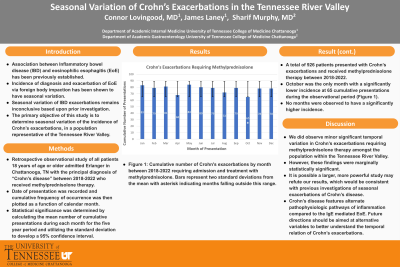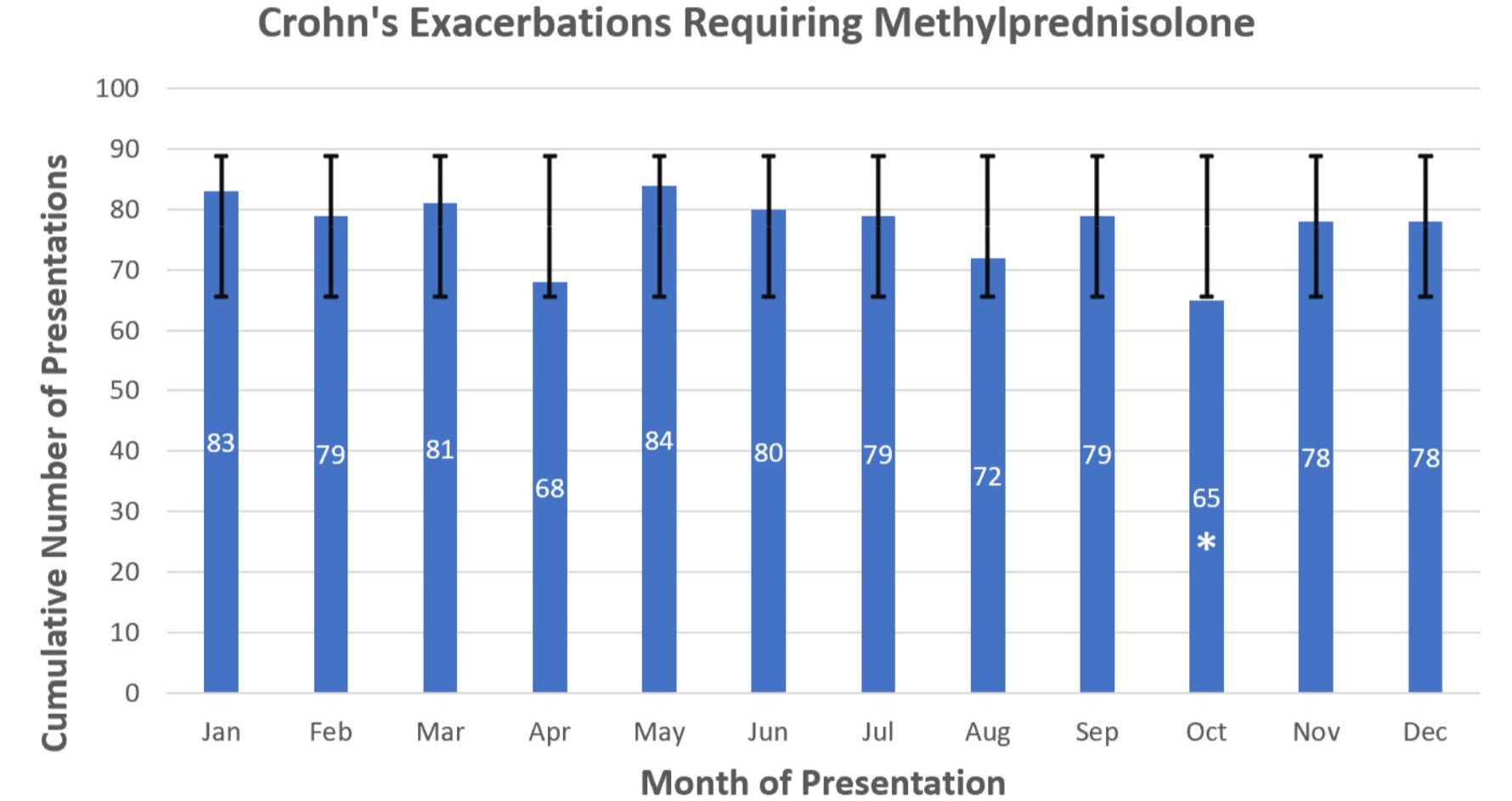Tuesday Poster Session
Category: IBD
P4360 - Seasonal Variation of Crohn’s Exacerbations in the Tennessee River Valley
Tuesday, October 29, 2024
10:30 AM - 4:00 PM ET
Location: Exhibit Hall E

Has Audio
- CL
Connor Lovingood, MD
University of Tennessee Health Science Center
Chattanooga, TN
Presenting Author(s)
Connor Lovingood, MD, James Laney, MD, Sharif Murphy, MD
University of Tennessee Health Science Center, Chattanooga, TN
Introduction: Association between Inflammatory bowel disease (IBD) and eosinophilic esophagitis (EoE) has been previously established. Incidence of diagnosis and exacerbation of EoE via foreign body impaction has been shown to have seasonal variation. Seasonal variation of IBD exacerbations remains inconclusive based upon prior investigation. The primary objective of this study is to determine seasonal variation of the incidence of Crohn’s exacerbations, in a population representative of the Tennessee River Valley.
Methods: Retrospective observational study of all patients 18 years of age or older admitted to the Baroness Erlanger Hospital, an academic tertiary referral hospital in Chattanooga TN, with the principal diagnosis of “Crohn’s disease” between 1/1/2018-12/31/2022. Patient data was collected by performing a database search of the electronic medical record for charts listing the principal diagnosis above who received methylprednisolone therapy during admission. The data was de-identified and the date of presentation was recorded. Cumulative frequency of occurrence was then plotted as a function of calendar month. Statistical significance was determined by calculating the mean number of cumulative presentations during each month for the five year period and utilizing the standard deviation to develop a 95% confidence interval.
Results: A total of 926 patients presented with Crohn’s exacerbations and received methylprednisolone therapy between 1/1/2018-12/31/2022. October was the only month with a significantly lower incidence at 65 cumulative presentations during the observational period (Figure 1). No months were observed to have a significantly higher incidence.
Discussion: We did observe minor significant temporal variation in Crohn’s exacerbations requiring methylprednisolone therapy amongst the population within the Tennessee River Valley. However, these findings were marginally statistically significant. It is possible a larger, more powerful study may refute our results, which would be consistent with previous investigations of seasonal exacerbations of Crohn’s disease. Crohn’s disease features alternate pathophysiologic pathways of inflammation compared to the IgE mediated EoE. Future directions should be aimed at alternative variables to better understand the timing of Crohn’s exacerbations.

Disclosures:
Connor Lovingood, MD, James Laney, MD, Sharif Murphy, MD. P4360 - Seasonal Variation of Crohn’s Exacerbations in the Tennessee River Valley, ACG 2024 Annual Scientific Meeting Abstracts. Philadelphia, PA: American College of Gastroenterology.
University of Tennessee Health Science Center, Chattanooga, TN
Introduction: Association between Inflammatory bowel disease (IBD) and eosinophilic esophagitis (EoE) has been previously established. Incidence of diagnosis and exacerbation of EoE via foreign body impaction has been shown to have seasonal variation. Seasonal variation of IBD exacerbations remains inconclusive based upon prior investigation. The primary objective of this study is to determine seasonal variation of the incidence of Crohn’s exacerbations, in a population representative of the Tennessee River Valley.
Methods: Retrospective observational study of all patients 18 years of age or older admitted to the Baroness Erlanger Hospital, an academic tertiary referral hospital in Chattanooga TN, with the principal diagnosis of “Crohn’s disease” between 1/1/2018-12/31/2022. Patient data was collected by performing a database search of the electronic medical record for charts listing the principal diagnosis above who received methylprednisolone therapy during admission. The data was de-identified and the date of presentation was recorded. Cumulative frequency of occurrence was then plotted as a function of calendar month. Statistical significance was determined by calculating the mean number of cumulative presentations during each month for the five year period and utilizing the standard deviation to develop a 95% confidence interval.
Results: A total of 926 patients presented with Crohn’s exacerbations and received methylprednisolone therapy between 1/1/2018-12/31/2022. October was the only month with a significantly lower incidence at 65 cumulative presentations during the observational period (Figure 1). No months were observed to have a significantly higher incidence.
Discussion: We did observe minor significant temporal variation in Crohn’s exacerbations requiring methylprednisolone therapy amongst the population within the Tennessee River Valley. However, these findings were marginally statistically significant. It is possible a larger, more powerful study may refute our results, which would be consistent with previous investigations of seasonal exacerbations of Crohn’s disease. Crohn’s disease features alternate pathophysiologic pathways of inflammation compared to the IgE mediated EoE. Future directions should be aimed at alternative variables to better understand the timing of Crohn’s exacerbations.

Figure: Figure 1: Cumulative number of Crohn's exacerbations by month between 1/1/2018-12/31/2022 requiring admission and treatment with methylprednisolone. Bars represent two standard deviations from the mean with asterisk indicating months falling outside this range.
Disclosures:
Connor Lovingood indicated no relevant financial relationships.
James Laney indicated no relevant financial relationships.
Sharif Murphy indicated no relevant financial relationships.
Connor Lovingood, MD, James Laney, MD, Sharif Murphy, MD. P4360 - Seasonal Variation of Crohn’s Exacerbations in the Tennessee River Valley, ACG 2024 Annual Scientific Meeting Abstracts. Philadelphia, PA: American College of Gastroenterology.
